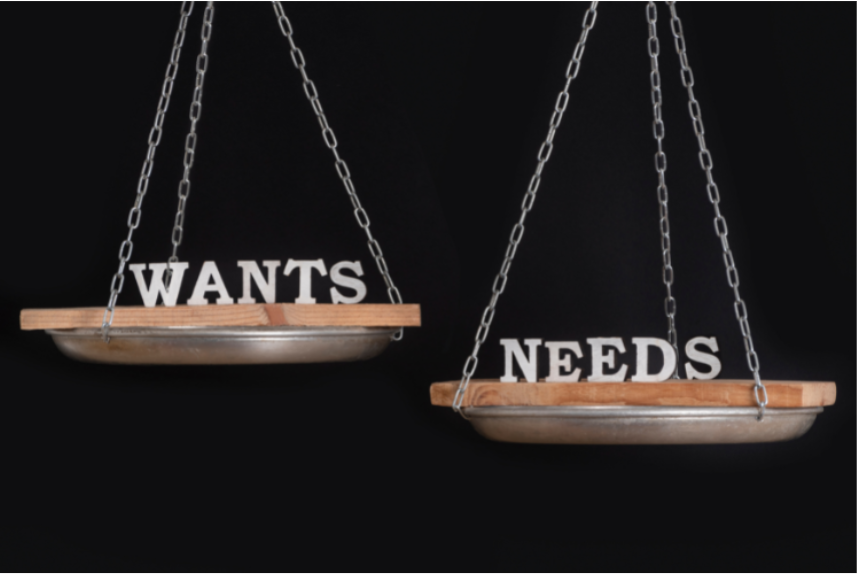
Creating a Balanced Budget that Accommodates Your Needs and Wants
It’s not always easy to tell the difference between what you actually need and what you just really want. As you watch your friends, coworkers, and people in your social media network achieve significant life milestones like purchasing their first home, upgrading their vehicles, and investing in properties, your wants may begin to feel more like necessities. If you don’t have enough money to match your peers’ spending, you run the risk of straining your finances both now and in the future.
It doesn’t matter if you’re a young adult in your 30s looking to purchase a car, a family looking to upgrade your residence, or a senior citizen with big travel plans; you run the risk of conflating your needs and wants.
Spending more of your income on wants rather than needs, you will have less money available for competing priorities, such as adequate life insurance, an education for your child, retirement savings account that is fully funded, or savings account for “rainy days” to cover unexpected expenses.
How to Balance Your Needs and Wants Within Your Budget
To ensure that you can make room for the things that are most important to you and to better equip yourself for a prosperous financial future, creating a budget is among the most crucial things you can do for yourself. When you create a budget that takes into account both the things you want and the things you need, you are putting a specific amount of money aside for a specific goal.
Answering these two crucial questions will help you get a better grasp on the specifics of budgeting:
What are the expenses that I need to factor into my budget?
Your needs are your day-to-day costs, such you can’t do without. Consider the cost of groceries, gas, the payment of your car, the payment of your rent or mortgage, and so on. These are the things that you need to make room for in your budget because if you don’t, you could end up in some dire financial straits.
Then, there are things that you want. These are typically the things that are enjoyable – the items and experiences that you want to have and for which you want to set aside money. For instance, getting together with some close friends or loved ones and going out to eat, seeing a concert, or getting away for the weekend.
Another consideration is the emergency fund, which is universally agreed to be the least desirable component. Putting some money aside for things that you hope will never happen, but which also occasionally do happen, is never a bad idea.
When you create a budget that divides your spending between your needs and your wants, you are providing yourself with the advantage of seeing all of your expenses and assessing what you truly need as opposed to what you really want.
How to Budget for Your Needs and Wants

Some of them may overlap after going through both your needs and wants.
Perhaps you prefer to buy a well-known brand rather than an unknown one. You may need a raincoat but want a designer one, which could cost you more. It all boils down to how much money you have available.
Because of this, it is essential to take a dispassionate look at your needs and preferences, determine where each one falls within the bigger picture, and evaluate the effect each factor has on your entire financial well-being.
One helpful piece of guidance is to make a list of everything you have to do and then begin classifying the items into the appropriate categories. Keeping tabs on your spending can reveal that some of the things you consider necessities are actually just extras.
Budgeting in 5 Easy Steps
- Start by calculating your monthly take-home pay, which is the money you have left over after taxes. Include all sources of income, including wages, government benefits, interest, dividends, commissions, and so on.
- Make sure your fixed monthly expenses take precedence over your discretionary spending – these are the things that you need to sustain your standard of living on a monthly basis. Included in this category are regular payments for things like rent, a mortgage, cell phone or internet service as well as fixed-term loans.
- Expenses that vary from month to month are variable expenses. Fuel, groceries, dining out, and entertainment costs are all included in these costs. Some may be required, while others might be scaled back if necessary.
- When it comes to irregular expenses, such as clothing or gifts, you should have a plan in place. You can set aside money to use in case of unforeseen expenses or a life event.
- After paying your bills, whatever money is left over can be put toward savings. Aim for the short term, an emergency fund and a retirement fund are examples of short-term savings objectives.
The Bottom line for Budgeting for Needs and Wants
The basic conclusion is that you must examine your finances logically from an objective viewpoint. Don’t be too lenient with yourself when it comes to deciding what you need vs want in life. The more truthful you are about how much money you spend, the more effectively your budget will work for you. If you start classifying what you consider to be “needs” as “wants,” you’ll find yourself blowing through your budget much faster than you expected.
To assist you in achieving your financial goals while allowing yourself some room for wiggle room, it is essential to stick to your budget.
Consult with a Professional

With the guidance of EmpireOne Credit Solutions debt experts, you can get a better understanding of your overall financial picture and identify areas where you can cut costs. If you’re also having debt problems, we can help to assist you in finding the best solution for your current situation. Book a free consultation with us today.





